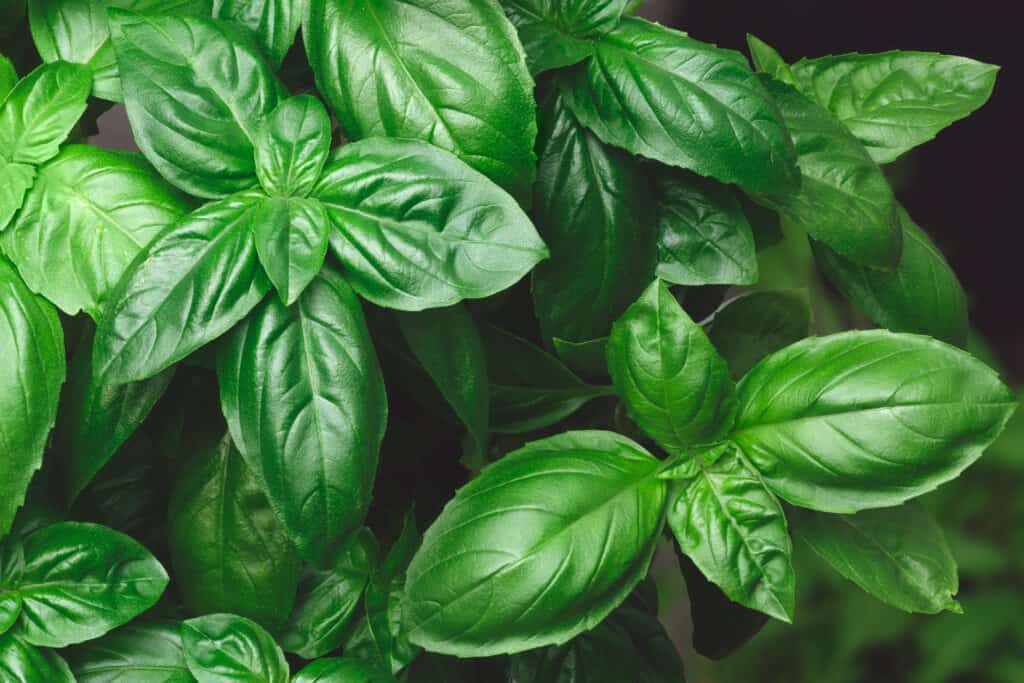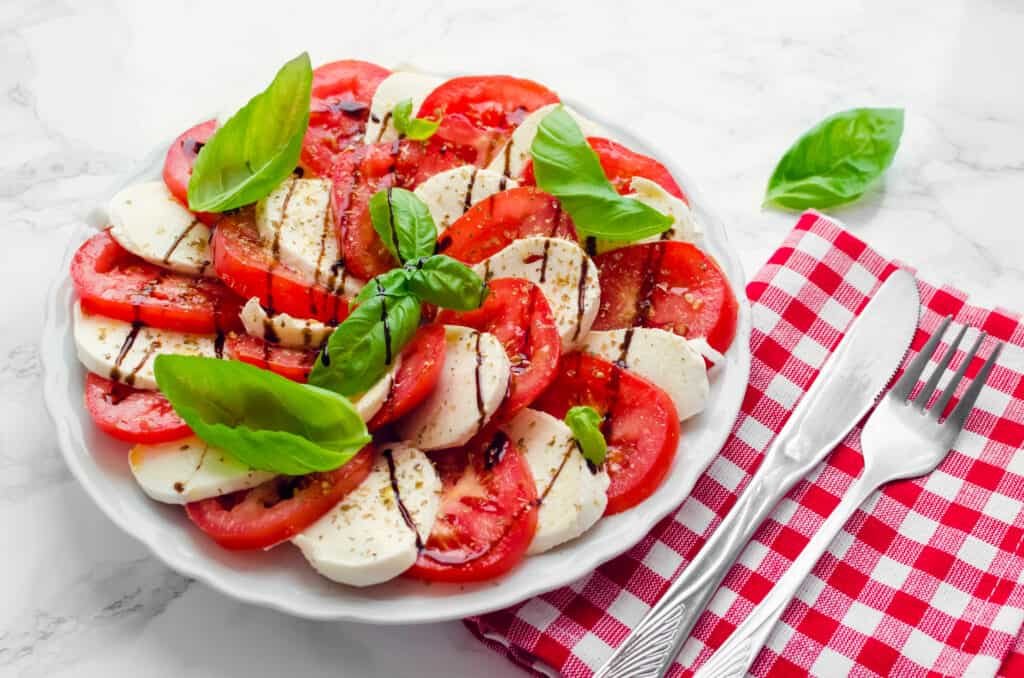Holy basil and basil are two popular varieties of basil. Among the most beloved culinary herbs, basil is a quite versatile, making it a splendid addition to recipes from Italian pasta to Thai curry. For home gardeners and home cooks, basil can be an introduction into growing and cooking with fresh herbs.
At first glance, holy basil and basil have any similarities, including:
- Both are members of the Lamiaceae family
- Both are species within the Ocimum genus
- Both are native to Southeast Asia, specifically India
- Both are used in multiple cultures’ cuisines as a garnish or cooking ingredient
- Both are relatively easy to grow in a home herb garden
Beyond these similarities, however, holy basil and basil have their own unique histories and uses. So which herb is the right choice for the garden or that special recipe? This article explores the differences between holy basil and basil, highlighting which variety is suitable for your specific needs.
Please note: A-Z Animals does not recommend plants or herbs for medicinal or health use. We present the following information for academic and historical purposes only.
Comparing Holy Basil and Basil
| Characteristic | Holy Basil | Basil |
|---|---|---|
| Scientific Name | Ocimum tenuiflorum | Ocimum basilicum |
| Family | Lamiaceae | Lamiaceae |
| Common Name | Holy basil, hot basil, Tulsi, Tulasi, Vrinda | Basil, sweet basil, great basil |
| Origin | Southeast Asia (India) | Southeast Asia (India) |
| Description of Plant | Holy basil is a perennial plant most often grown as an annual. It typically grows no taller than two feet. Holy basil leaves are simple and grow oppositely along a hairy stem. Each leaf has toothed margins and is either green or purple in color, depending on the type. Holy basil is a flowering plant, which bears small purple or white flowers, each of which produces many seeds. | Basil, or great basil, is a small perennial plant that is often grown as an annual. Basil plants typically grow to be between 12 and 18 inches tall. The leaves are simple and grow oppositely in spear shapes. The edges are smooth. Basil leaves usually grow to be one or two inches long and are dark or bright green. The flowers of basil are purple and produce many seeds. |
| Growing Conditions | Holy basil grows best in warm temperatures. This can include indoors on a windowsill, outdoors in a summer herb garden, or year-round in tropical to subtropical climates. It grows well in full or partial sunlight. | Basil grows best outdoors, but may also be grown inside as a container plant. Like holy basil, when grown outdoors basil will thrive in a summer herb garden or year-round in tropical to subtropical climates. When grown indoors, the plants need at least six hours of sunlight each day. |
| USDA Hardiness Zone(s) | Zones 3 – 9 (summer annual) Zones 10 – 11 (perennial) | Zones 3 – 9 (summer annual) Zones 10 – 11 (perennial) |
| Flavor | Peppery, clove-like, spicy | Sweet, fresh, minty, anise-like |
Holy Basil and Basil: Description
Basil is a general term that refers to multiple species and varieties of herb plants in the genus Ocimum,.in the family Lamiaceae. Along with basil, members of the Lamiaceae family include rosemary, oregano, thyme, and lavender, to name a few.
The Ocimum genus contains more than 150 different species of basil plants! Among these species are holy basil, Ocimum tenuiflorum, and basil, Ocimum basilicum. There are multiple varieties of the Ocimum basilicum species, including Ocimum basilicum var. thyrsiflora ,Thai basil and Ocimum basilicum var. citriodora, lemon basil. These varieties have distinctive appearances and flavors. However, when used alone, the word “basil” most frequently refers to Ocimum basilicum.
Description of Holy Basil
Holy basil is the common English name for the species Ocimum tenuiflorum. However, holy basil has been cultivated for thousands of years in Southeast Asia. In India holy basil is called tulsi or hot basil. Because it is often used in Ayurvedic medicine to teat illness. Also called Tulasi or Vrinda, after the Hindu goddesses, holy basil can often be found adorning Hindu shrines.
Holy basil has green or purple leaves, depending on the variety. The leaves have toothed margins and grow oppositely along a hairy green stem. Plants can grow to be up to two feet tall. Holy basil flowers with purple or white blossoms which produce many seeds.

Holy basil can often be found adorning Hindu shrines.
©muthugpd/Shutterstock.com
Description of Basil
Ocimum basilicum, the species commonly known as basil, is native to India but has been grown and enjoyed around the globe for centuries.
Ocimum basilicum is a member of the Lamiaceae family along with holy basil. The leaves are bright green and tend to grow to be two to three inches long. The plant itself grows erect, reaching heights of up to two feet, with plump, spear-shaped leaves with smooth margins. Basil the most commonly-grown of all basil varieties.

Basil leaves plump and spear-shaped, with smooth margins.
©Hortimages/Shutterstock.com
Differences
History
Both holy basil and basil are native to Southeast Asia. However, holy basil inhabits a particularly important and unique place in Southeast Asian history and culture. Holy basil gained its name from the cultural belief in India that it has special spiritual powers and can impart great medicinal benefits to those who eat it. Though holy basil likely comes from Northern India, it now grows in many tropical and subtropical climates throughout Asia and the world. Holy basil remains an important part of Ayurvedic medicine, spiritual practice, and an ingredient in cooking.
Though basil is thought to have also originated in Southeast Asia, it has long been found in other parts of the world, including ancient Egypt and ancient Greece. Historians believe that in ancient times, basil was traded along with other spices on trade routes that carried goods across the continental area of Eurasia. For hundreds, or even thousands of years, basil has been grown throughout the Mediterranean. Eventually, it made its way to other parts of Europe, and then North America. Today, basil is a commonly-grown herb popular throughout the world and a staple ingredient in Mediterranean countries, as well as Asia and the United States.
Appearance
One of the biggest differences between holy basil and basil is found in their appearance.
While holy basil leaves may be green or purple leaves, basil has bright green leaves. Holy basil leaves grow oppositely along a square, hairy stem. In contrast, though basil leaves grow oppositely from square stems, their stem is smooth. One of the best ways to identify whether a plant is holy basil or basil is by looking at the leaves. The leaves of holy basil are toothed, with notches along the entire margin of the leaves, and flat. The basil leaves, on the other hand, are plump, slightly rounder in shape, curl downward, and have smooth edges.
When they’re blooming, the flowers are another way to differentiate holy basil from basil. While the flowers of the holy basil can be white or purple, basil flowers are white.
Growing Conditions
Both holy basil and basil are relatively easy to grow and bring immediate rewards upon harvesting. Both plants thrive in conditions similar to their native climate, and can be grown outdoors in the summer in USDA Zones 3-9, or year-round in USDA hardiness Zones 10-11, where they are grown as perennials.
The Farmers’ Almanac recommends several tips for growing big, healthy, bushy basil, including keeping the plants warm, keeping the soil moist, watering the soil, (not the leaves), and letting the sunshine in. The Farmers’ Almanac also recommends fertilizing soil every few weeks, to give plants a nutrient boost.
Another important tip for growing any type of basil is to harvest early and often. Basil leaves will develop a more bitter taste when left to grow. Additionally, pruning is a necessary step in preventing the basil plant from flowering. If you do not trim or harvest leaves from your basil plant, flower buds will begin to develop. The plant’s energy will be siphoned into growing seeds, rather than producing leaves. It is that flowering process that changes the taste of basil leaves from sweet to much more bitter and less appetizing.
Harvest about 20% of the plant at a time. This will ensure that your basil plant, either holy basil or basil, Will continue to growing and producing ample foliage.

Harvest basil early and often to extend the life of your plant.
©Billion Photos/Shutterstock.com
Uses
Holy Basil
Holy basil is used in Ayurvedic medicine to treat pain, anxiety, chronic stress, diabetes, high cholesterol, and a range of other medical conditions. However, there is not conclusive scientific evidence that holy basil can address or cure any medical conditions. Some studies have suggested that it may provide therapeutic benefits to those who consume it. Further research is needed to determine whether holy basil has any measurable health benefits and what those might be.
In addition to its uses in Ayurvedic medicine, holy basil is incorporated into other spiritual practices. Hindus consider holy basil to be sacred, so it is often placed it in homes and temples throughout India. It is considered rasayana: that which nourishes holistic well-being and promotes a long, healthy life.
Because holy basil has a spicy, peppery flavor, it is often a key ingredient or garnish in many dishes including Cambodian, Indian, Thai, and Vietnamese cuisine. Recipes for curry, pho soup, or vegetable salads also use holy basil. It brings a bite and flavorful spice to each of these dishes.
Basil
Basil, on the other hand, is more of a staple in Mediterranean dishes. Because it has a sweeter, anise-like flavor, basil adds a distinctive aroma and taste to various dishes from Italy and Greece, and uniquely North American recipes. Basil is the most popular variety in the U.S.
Basil is the main ingredients in pesto, a flavorful sauce often used on pizza or in pasta. It is a popular addition to Mediterranean salads, such as caprese salad, which also includes mozzarella and tomatoes. Fresh basil is a garnish on a wide variety of dishes, from vegetables to pasta or soups.
Fresh basil can be found in the produce section of the neighborhood grocery, while dried basil leaves are sold in the spice section. Cooks use basil in combination with other spices like oregano and garlic. This is an especially popular blend in Italian, or more broadly, Mediterranean dishes.

Basil is a welcome addition to a caprese salad.
©Nelli Syrotynska/Shutterstock.com
In Summary
Whether you are thinking about growing them in an outdoor herb garden or as a container plants indoors, both holy basil and basil are easy to cultivate plants that add add delicious flavor to your recipes. Remember that harvesting the leaves regularly will keep the plant healthy and extend its life. Once they flower, it’s time to pull up these plants, as the leaves will have become bitter.
Next Up
The photo featured at the top of this post is © iStock.com/Abul Hossain Asif
Sources
- Iowa State University, Available here: https://hortnews.extension.iastate.edu/1997/3-21-1997/basil.html#:~:text=It%20is%20native%20to%20Asia,and%20beliefs%20associated%20with%20it.
- The Spruce, Available here: https://www.thespruceeats.com/what-is-basil-1807985
- Encyclopedia Brittanica, Available here: https://www.britannica.com/plant/basil
- Evid Based Complement Alternat Med., Available here: https://www.ncbi.nlm.nih.gov/pmc/articles/PMC5376420/
- Farmers' Almanac, Available here: https://www.farmersalmanac.com/8-tips-to-grow-big-bushy-basil-130968
- Clemson Home & Garden Center, Available here: https://hgic.clemson.edu/factsheet/basil/
Thank you for reading! Have some feedback for us? Contact the AZ Animals editorial team.






